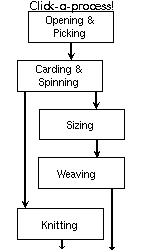

| PROCESS | INPUTS | WASTES | ||||
|---|---|---|---|---|---|---|
| Raw materials | Water | Energy | Liquid | Solid | Gas | |
| Raw cotton 1050-1150 Kg [20](1) | N.A. | Waste lint 50-80 Kg [12](4) | ||||
| Mineral Oil Non-ionic emulsifier Soluble Fatty Ester | El. 4860-5400 KWh [14](2), 3125 kWh [7] | N.A. | ||||
| Starch or modified starch compounds 100-150 Kg [19] (3) | 2.5 m3 [22] (6) | N.A. | pH 7-9.5 BOD 0.5-5 Kg [8] TS 47-67 Kg (5), FLOW 0.2-4 m3 | Vapours Particulate | ||
| (5) | Electricity 3680-4760 KWh [14] | |||||
| Electricity 1290-1750 KWh [14] | (7) | |||||
(1) Cotton may contain 4-12% by weight of impurities [3]. From this data, the amount of raw cotton needed to obtain 1 tonne of cotton fabric has been calculated.
(2) Energy required for spinning only. Value for carding is not available.
(3) For cotton and cotton blends. From 30 to 50 Kg if synthetic filaments are the raw materials according to reference [19].
(4) As stated by Lund (reference [12]), lint and dust in opening and picking rooms are collected by vacuum system. This collected lint is salable at a low price according to this author.
(5) As was mentioned earlier, weaving is a dry operation but is normally carried out in buildings maintained at high humidity. Cooling and humidifying water used in a greige mill represents a substantial portion of the total water usage.
(6)Tables 3.1 and 3.2 give the amount of water typically used and the waste load for Dry Processing mills as extracted from reference [10].
(7) According also to reference [10], effluent generated from knit greige goods is generally nil. If any wastes are generated through spills, clean-up or possible washing of the final products, the only pollutant would be knitting oils but no difference is made in the data given for pollution parameters or water consumption.
| Minimum | Median | Maximum |
|---|---|---|
| 0.8 | 9.2 | 140.1 |
| Units | BOD | COD | TSS | O&G | Phenol | Cr | Sulphide |
|---|---|---|---|---|---|---|---|
| mg/l | 350 | 1000 | 200 | - | - | 0.014 | 8.0 |
| Kg/t | 2.3 | 14.5 | 1.6 | N.A. | N.A. | N.A. | N.A. |